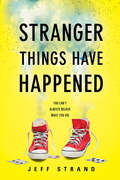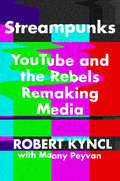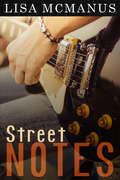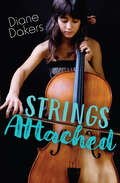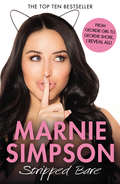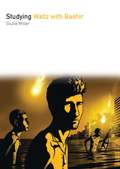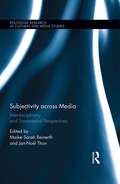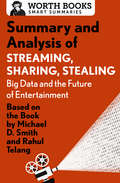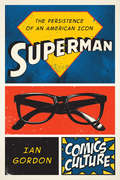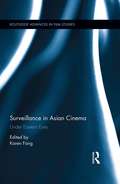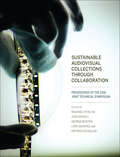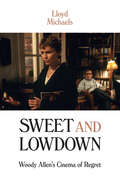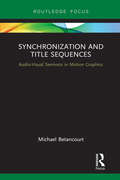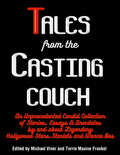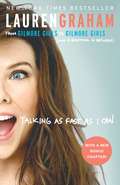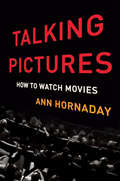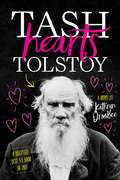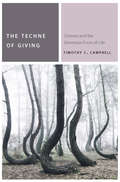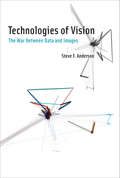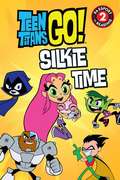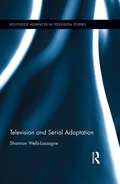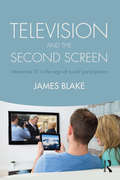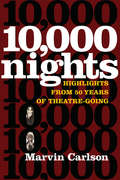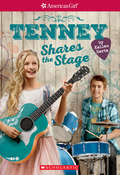- Table View
- List View
Stranger Things Have Happened
by Jeff StrandYou can't always believe what you see in this hilarious coming of age novel from the author of The Greatest Zombie Movie Ever and I Have a Bad Feeling about ThisHarry Houdini. Penn and Teller. David Copperfield. Marcus Millian the Third. Okay, so Marcus isn't a famous magician. He may not even be a great magician. But his great-grandfather, the once-legendary and long-retired Zachary the Stupendous, insists Marcus has true talent. And when Grandpa Zachary boasts that he and Marcus are working on an illusion that will shock, stun, and astonish, Marcus wishes he could make himself disappear. The problem? Marcus also has stage fright-in spades. It's one thing to perform elaborate card tricks in front of his best friend, Kimberly, but it's an entirely different feat to perform in front of an audience. Then Grandpa Zachary dies in his sleep. To uphold his great-grandfather's honor, the show must go on. It would take a true sorcerer to pull off the trick Marcus has planned. But maybe he's the next best thing...
Streampunks: YouTube and the Rebels Remaking Media
by Maany Peyvan Robert KynclAn entertainment and tech insider—YouTube’s chief business officer—delivers the first detailed account of the rise of YouTube, the creative minds who have capitalized on it to become pop culture stars, and how streaming video is revolutionizing the media world.In the past ten years, the internet video platform YouTube has changed media and entertainment as profoundly as the invention of film, radio, and television did, more than six decades earlier. Streampunks is a firsthand account of this upstart company, examining how it evolved and where it will take us next.Sharing behind-the-scenes stories of YouTube’s most influential stars—Streampunks like Tyler Oakley, Lilly Singh, and Casey Neistat—and the dealmakers brokering the future of entertainment like Scooter Braun and Shane Smith, Robert Kyncl uses his experiences at three of the most innovative media companies, HBO, Netflix, and YouTube, to tell the story of streaming video and this modern pop culture juggernaut. Collaborating with Google speechwriter Maany Peyvan, Kyncl explains how the new rules of entertainment are being written and how and why the media landscape is radically changing, while giving aspiring Streampunks some necessary advice to launch their own new media careers.Kyncl persuasively argues that, despite concerns about technology impoverishing artists or undermining artistic quality, the new media revolution is actually fueling a creative boom and leading to more compelling, diverse, and immersive content. Enlightening, surprising, and thoroughly entertaining, Streampunks is a revelatory ride through the new media rebellion that is reshaping our world.
Street Notes
by Lisa McmanusAll 15-year-old Nick Zinsky wanted was a guitar of his own and a necklace for his mom, and he wanted to buy both on his own, without anyone’s help.Nick’s mom want him to focus on school and not get a job. But Nick is anxious to save up, so he spends the summer and weekends busking downtown with a guitar loaned from school – a secret he has to keep from his mom, his music teacher, his friends, and especially from the school bully, Beau. But when a music competition is announced where the prizes would solve all Nick’s problems, Nick lacks the confidence to enter. Can he find the courage to enter and will it make his problems disappear? Author note: ‘Street Notes’ is a story about bullying, a teens’ struggle for independence, and about learning that sometimes it’s okay to ask for help. This book was previously published with the title “Newbie Nick” in June 2014.
Strings Attached (Orca Limelights)
by Diane DakersBrielle and Tawni have played cello side by side in orchestras since they were nine years old. Brielle has always played second chair to Tawni’s first, and she's been happy with that arrangement. When Tawni is injured, Brielle suddenly finds herself principal cellist. Not only does that mean she'll be thrust into the spotlight, but it also means she is now leader of the cello section. Brielle is terrified. Is she good enough? Will the other musicians accept her? What if she screws up? Despite her fears, Brielle rises to the occasion. Her cello skills, and her leadership skills, improve as she grows into her new role. But just as Brielle is beginning to feel confident, Tawni returns. And she wants her job back. If Brielle steps down now, she'll lose her place in the spotlight. If she doesn't, her friendship could be in jeopardy.
Studying Waltz with Bashir (Studying Films)
by Giulia MillerOn its release in 2008, Ari Folman's animated documentary Waltz with Bashir was heralded as a brilliant and original exploration of trauma, and trauma's impact on memory and the recording of history. But it is surprising that although the film is seen through the eyes of one particular soldier, a viewpoint portrayed using highly experimental forms of animation, this has not prevented Waltz with Bashir from being regarded as both an 'autobiographical' and 'honest' account of the director's own experiences in the 1982 Lebanon war. In fact, the film won several documentary awards, and even those critics focusing on the representation of trauma suggest that this trauma must be authentic. In this sense, it is the documentary form rather than the animation that has had the most influence upon critics.As Studying Waltz with Bashir will show, it is the tension between the two forms that makes the film so complex and interesting, allowing for multiple themes and discourses to coexist, including Israel's role during the Lebanon War and the impact of trauma upon narrative, but also the representation of Holocaust memory and its role in the formation of Israeli identity. In addition to these themes that coexist by virtue of the film's unusual animated documentary format, Waltz with Bashir can also be discussed in relation to a broad range of contexts; for example, the representation of war in film, the history of Israeli Holocaust cinema, and recent trends in experimental animation, such as Richard Linklater's Waking Life (2001) and A Scanner Darkly (2006), as well as Folman's most recent live action/animation work The Congress (2013).
Subjectivity across Media: Interdisciplinary and Transmedial Perspectives (Routledge Research in Cultural and Media Studies)
by Jan-Noël Thon Maike Sarah ReinerthMedia in general and narrative media in particular have the potential to represent not only a variety of both possible and actual worlds but also the perception and consciousness of characters in these worlds. Hence, media can be understood as "qualia machines," as technologies that allow for the production of subjective experiences within the affordances and limitations posed by the conventions of their specific mediality. This edited collection examines the transmedial as well as the medium-specific strategies employed by the verbal representations characteristic for literary texts, the verbal-pictorial representations characteristic for comics, the audiovisual representations characteristic for films, and the interactive representations characteristic for video games. Combining theoretical perspectives from analytic philosophy, cognitive theory, and narratology with approaches from phenomenology, psychosemiotics, and social semiotics, the contributions collected in this volume provide a state-of-the-art map of current research on a wide variety of ways in which subjectivity can be represented across conventionally distinct media.
Summary and Analysis of Streaming, Sharing, Stealing: Big Data and the Future of Entertainment
by Worth BooksSo much to read, so little time? This brief overview of Streaming, Sharing, Stealing tells you what you need to know—before or after you read Michael D. Smith’s and Rahul Telang’s book. Crafted and edited with care, Worth Books set the standard for quality and give you the tools you need to be a well-informed reader. This short summary and analysis of Michael D. Smith and Rahul Telang’s Streaming, Sharing, Stealing includes: Historical context, Chapter-by-chapter summaries, Character profiles, Important quotes, Fascinating trivia, Glossary of terms, Supporting material to enhance your understanding of the original work. About Streaming, Sharing, Stealing by Michael D. Smith and Rahul Telang: There is a new world order in the entertainment industry. Digital technology has contributed to an explosion of content in the entertainment business as Netflix, Amazon, and Apple upend traditional entertainment, changing the way in which television, film, music, and books are made and consumed. In Streaming, Sharing, Stealing: Big Data and the Future of Entertainment, authors Smith and Telang document this massive change and demonstrate conclusively that making data-driven decisions and understanding customer behavior are the keys to the new marketplace. The summary and analysis in this ebook are intended to complement your reading experience and bring you closer to a great work of nonfiction.
Superman: The Persistence of an American Icon
by Ian GordonAfter debuting in 1938, Superman soon became an American icon. But why has he maintained his iconic status for nearly 80 years? And how can he still be an American icon when the country itself has undergone so much change?Superman: Persistence of an American Icon examines the many iterations of the character in comic books, comic strips, radio series, movie serials, feature films, television shows, animation, toys, and collectibles over the past eight decades. Demonstrating how Superman’s iconic popularity cannot be attributed to any single creator or text, comics expert Ian Gordon embarks on a deeper consideration of cultural mythmaking as a collective and dynamic process. He also outlines the often contentious relationships between the various parties who have contributed to the Superman mythos, including corporate executives, comics writers, artists, nostalgic commentators, and collectors. Armed with an encyclopedic knowledge of Superman’s appearances in comics and other media, Gordon also digs into comics archives to reveal the prominent role that fans have played in remembering, interpreting, and reimagining Superman’s iconography. Gordon considers how comics, film, and TV producers have taken advantage of fan engagement and nostalgia when selling Superman products. Investigating a character who is equally an icon of American culture, fan culture, and consumer culture, Superman thus offers a provocative analysis of mythmaking in the modern era.
The Surreal Life of Leonora Carrington
by Joanna MoorheadIn 2006 journalist Joanna Moorhead discovered that her father's cousin, Prim, who had disappeared many decades earlier, was now a famous artist in Mexico. Although rarely spoken of in her own family (regarded as a black sheep, a wild child; someone they were better off without) in the meantime Leonora Carrington had become a national treasure in Mexico, where she now lived, while her paintings are fetching ever-higher prices at auction today.Intrigued by her story, Joanna set off to Mexico City to find her lost relation. Later she was to return to Mexico ten times more between then and Leonora's death in 2011, sometimes staying for months at a time and subsequently travelling around Britain and through Europe in search of the loose ends of her tale. They spent days talking and reading together, drinking tea and tequila, going for walks and to parties and eating take away pizzas or dining out in her local restaurants as Leonora told Joanna the wild and amazing truth about a life that had taken her from the suffocating existence of a debutante in London via war-torn France with her lover, Max Ernst, to incarceration in an asylum and finally to the life of a recluse in Mexico City.Leonora was one of the last surviving participants in the Surrealist movement of the 1930s, a founding member of the Women's Liberation Movement in Mexico during the 1970s and a woman whose reputation will survive not only as a muse but as a novelist and a great artist. This book is the extraordinary story of Leonora Carrington's life, and of the friendship between two women, related by blood but previously unknown to one another, whose encounters were to change both their lives.
Surveillance in Asian Cinema: Under Eastern Eyes (Routledge Advances in Film Studies)
by Karen FangCritical theory and popular wisdom are rife with images of surveillance as an intrusive, repressive practice often suggestively attributed to eastern powers and opposed to western liberalism. Hollywood-dominated global media has long promulgated a geopoliticized east-west axis of freedom vs. control. This book focuses on Asian and Asia-based films and cinematic traditions obscured by lopsided western hegemonic discourse and—more specifically—probes these films’ treatments of a phenomenon that western film often portrays with neo-orientalist hysteria. Exploring recent and historical movies made in post-social and anti-Communist societies such as China, Hong Kong, Taiwan, Vietnam and South Korea, the book picks up on the political and economic concerns implicitly underlying Sinophobic and anti-Communist Asian images in Hollywood films while also considering how these societies and states depict the issues of centralization, militarization and technological innovation so often figured as distinctive of the difference between eastern despotism and western liberalism.
Sustainable Audiovisual Collections Through Collaboration: Proceedings of the 2016 Joint Technical Symposium
by Rachael Stoeltje Vicki Shively George Boston Lars Gaustad Dietrich SchüllerThe art and science of audiovisual preservation and access has evolved at breakneck speed in the digital age. The Joint Technical Symposium (JTS) is organized by the Coordinating Council of Audiovisual Archives Associations and brings experts from around the world to learn of technologies and developments in the technical issues affecting the long-term survival and accessibility of audiovisual collections. This collection of essays is derived from presentations made at the 2016 JTS held in Singapore and presents an overview of the latest audiovisual preservation methods and techniques, archival best practices in media storage, as well as analog-to-digital conversion challenges and their solutions.
Sweet and Lowdown: Woody Allen's Cinema of Regret
by Lloyd MichaelsOver a career that has spanned more than six decades, Woody Allen has explored the emotion of regret as a response to the existentialist dilemma of not being someone else. Tracing this recurrent theme from his stand-up comedy routines and apprentice work through classics like Annie Hall, Manhattan, The Purple Rose of Cairo, Hannah and Her Sisters, and Bullets Over Broadway as well as less esteemed accomplishments (Another Woman, Sweet and Lowdown, Cassandra's Dream), this volume argues that it is ultimately the shallowness of his protagonists' regret—their lack of deeply felt, sustained remorse—that defines Allen's pervasive view of human experience. Drawing on insights from philosophy, theology, psychology, and literature, the book discusses nearly every Woody Allen film, with extended analyses of the relationship films (including Alice and Husbands and Wives), the murder tetralogy (including Match Point and Irrational Man), the self-reflexive films (including Stardust Memories and Deconstructing Harry), and the movies about nostalgia (including Radio Days and Midnight in Paris). The book concludes by considering Allen's most affirmative resolution of regret (Broadway Danny Rose) and speculating about the relevance of this through-line for understanding Allen's personal life and prospects as an octogenarian auteur.
Synchronization and Title Sequences: Audio-Visual Semiosis in Motion Graphics (Routledge Studies in Media Theory and Practice)
by Michael BetancourtSynchronization and Title Sequences proposes a semiotic analysis of the synchronization of image and sound in motion pictures using title sequences. Through detailed historical close readings of title designs that use either voice-over, an instrumental opening, or title song to organize their visuals—from Vertigo (1958) to The Player (1990) and X-Men: First Class (2011)—author Michael Betancourt develops a foundational framework for the critique and discussion of motion graphics’ use of synchronization and sound, as well as a theoretical description of how sound-image relationships develop on-screen.
Tales from the Casting Couch: An Unprecedented Candid Collection of Stories, Essays, and Anecdotes by and about Legendary Hollywood Stars, Starlets, and Wanna-Bes
by Michael Viner Terrie Maxine FrankelIn Hollywood, securing a coveted role in a big-budget film or landing a part in a prestigious feature sometimes doesn' t come down to who or what you know— but how far you' re willing to go. Tales from the Casting Couch is an anthology of little-known stories and anecdotes about actual casting sessions that propelled then-unknown actors to fame or established stars who secured themselves second acts. Learn how Dustin Hoffman mumbled his way out of the wrong job, why Orson Welles got a second chance from Lucy and Desi, and much more. This collection of stories features many Hollywood' s stars and legends, such as Sally Field, Whoopi Goldberg, Steve Martin, Robert Redford, Sylvester Stallone, John Travolta, and many, many others. In chapters like “ Chutzpah,” “ Size Is Everything,” “ Date with Destiny,” and “ Sex, Sex, Sex,” everyone from actors and actresses to producers and casting directors share some of the most outrageous stories about life behind the scenes in Tinseltown.
Talking as Fast as I Can: From Gilmore Girls to Gilmore Girls (and Everything in Between)
by Lauren Graham<P>In this collection of personal essays, the beloved star of Gilmore Girls and Parenthood reveals stories about life, love, and working as a woman in Hollywood--along with behind-the-scenes dispatches from the set of the new Gilmore Girls, where she plays the fast-talking Lorelai Gilmore once again. <P> In Talking as Fast as I Can, Lauren Graham hits pause for a moment and looks back on her life, sharing laugh-out-loud stories about growing up, starting out as an actress, and, years later, sitting in her trailer on the Parenthood set and asking herself, "Did you, um, make it?" She opens up about the challenges of being single in Hollywood ("Strangers were worried about me; that's how long I was single!"), the time she was asked to audition her butt for a role, and her experience being a judge on Project Runway ("It's like I had a fashion-induced blackout"). <P>In "What It Was Like, Part One," Graham sits down for an epic Gilmore Girls marathon and reflects on being cast as the fast-talking Lorelai Gilmore. The essay "What It Was Like, Part Two" reveals how it felt to pick up the role again nine years later, and what doing so has meant to her. Some more things you will learn about Lauren: She once tried to go vegan just to bond with Ellen DeGeneres, she's aware that meeting guys at awards shows has its pitfalls ("If you're meeting someone for the first time after three hours of hair, makeup, and styling, you've already set the bar too high"), and she's a card-carrying REI shopper ("My bungee cords now earn points!"). Including photos and excerpts from the diary Graham kept during the filming of the recent Gilmore Girls: A Year in the Life, this book is like a cozy night in, catching up with your best friend, laughing and swapping stories, and--of course--talking as fast as you can. <P><b>A New York Times Bestseller</b>
Talking Pictures: How to Watch Movies
by Ann HornadayWhether we are trying to impress a date after an art-house film screening or discussing Oscar nominations with friends, we all need ways to watch and talk about movies. But with so much variety between an Alfred Hitchcock thriller and a Nora Ephron romantic comedy, how can everyday viewers determine what makes a good movie?In Talking Pictures, veteran film critic Ann Hornaday walks us through the production of a typical movie-from writing the script and casting to the final sound edit-and explains how to evaluate each piece of the process. How do we know if a film is well-written, above and beyond snappy dialogue? What constitutes a great screen performance? What goes into praiseworthy cinematography, editing, and sound design? And what does a director really do? Full of engaging anecdotes and interviews with actors and filmmakers, Talking Pictures will help us see movies in a whole new light-not just as fans, but as film critics in our own right.
Tash Hearts Tolstoy
by Kathryn Ormsbee<p>From the author of <i>Lucky Few</i> comes a quirky teen novel about Internet fame, peer pressure, and remembering not to step on the little people on your way to the top! <p>After a shout-out from one of the Internet’s superstar vloggers, Natasha “Tash” Zelenka suddenly finds herself and her obscure, amateur web series, Unhappy Families, thrust in the limelight: She’s gone viral. Her show is a modern adaption of Anna Karenina—written by Tash’s literary love Count Lev Nikolayevich “Leo” Tolstoy. <p>Tash is a fan of the 40,000 new subscribers, their gushing tweets, and flashy Tumblr gifs. Not so much the pressure to deliver the best web series ever. And when Unhappy Families is nominated for a Golden Tuba award, Tash’s cyber-flirtation with a fellow award nominee suddenly has the potential to become something IRL—if she can figure out how to tell said crush that she’s romantic asexual. <p>Tash wants to enjoy her newfound fame, but will she lose her friends in her rise to the top? What would Tolstoy do?
The Techne of Giving: Cinema and the Generous Form of Life
by Timothy C. CampbellOver the last five years, corporations and individuals have given more money, more often, to charitable organizations than ever before. What could possibly be the downside to inhabiting a golden age of gift-giving? That question lies at the heart of Timothy Campbell’s account of contemporary giving and its social forms. In a milieu where gift-giving dominates, nearly everything given and received becomes the subject of a calculus—gifts from God, from benefactors, from those who have. Is there another way to conceive of generosity? What would giving and receiving without gifts look like? A lucid and imaginative intervention in both European philosophy and film theory, The Techne of Giving investigates how we hold the objects of daily life—indeed, how we hold ourselves—in relation to neoliberal forms of gift-giving. Even as instrumentalism permeates giving, Campbell articulates a resistant techne locatable in forms of generosity that fail to coincide with biopower’s assertion that the only gifts that count are those given and received. Moving between visual studies, Winnicottian psychoanalysis, Foucauldian biopower, and apparatus theory, Campbell makes a case for how to give and receive without giving gifts. In the conversation between political philosophy and classic Italian films by Visconti, Rossellini, and Antonioni, the potential emerges of a generous form of life that can cross between the visible and invisible, the fated and the free.
Technologies of Vision: The War Between Data and Images (The\mit Press Ser.)
by Steve F AndersonAn investigation of the computational turn in visual culture, centered on the entangled politics and pleasures of data and images.If the twentieth century was tyrannized by images, then the twenty-first is ruled by data. In Technologies of Vision, Steve Anderson argues that visual culture and the methods developed to study it have much to teach us about today's digital culture; but first we must examine the historically entangled relationship between data and images. Anderson starts from the supposition that there is no great divide separating pre- and post-digital culture. Rather than creating an insular field of new and inaccessible discourse, he argues, it is more productive to imagine that studying “the digital” is coextensive with critical models—especially the politics of seeing and knowing—developed for understanding “the visual.”Anderson's investigation takes on an eclectic array of examples ranging from virtual reality, culture analytics, and software art to technologies for computer vision, face recognition, and photogrammetry. Mixing media archaeology with software studies, Anderson mines the history of technology for insight into both the politics of data and the pleasures of algorithms. He proposes a taxonomy of modes that describe the functional relationship between data and images in the domains of space, surveillance and data visualization. At stake in all three are tensions between the totalizing logic of data and the unruly chaos of images.
Teen Titans Go! (TM): Silkie Time
by Magnolia BelleLearn about the Teen Titans' mascot and everybody's favorite worm, Silkie! Passport to Reading Level 2 TM & © DC Comics. (s17)
Television and Serial Adaptation (Routledge Advances in Television Studies)
by Shannon Wells-LassagneAs American television continues to garner considerable esteem, rivalling the seventh art in its "cinematic" aesthetics and the complexity of its narratives, one aspect of its development has been relatively unexamined. While film has long acknowledged its tendency to adapt, an ability that contributed to its status as narrative art (capable of translating canonical texts onto the screen), television adaptations have seemingly been relegated to the miniseries or classic serial. From remakes and reboots to transmedia storytelling, loose adaptations or adaptations which last but a single episode, the recycling of pre-existing narrative is a practice that is just as common in television as in film, and this text seeks to rectify that oversight, examining series from M*A*S*H to Game of Thrones, Pride and Prejudice to Castle.
Television and the Second Screen: Interactive TV in the age of social participation
by James BlakeTelevision is changing almost beyond recognition. In the battle for consumers, social media sites, smart phones and tablets have become rivals to traditional linear TV. However, audiences and producers are also embracing mobile platforms to enhance TV viewing itself. This book examines the emerging phenomenon of the second screen: where users are increasingly engaging with content on two screens concurrently. The practice is transforming television into an interactive, participatory and social experience. James Blake examines interactive television from three crucial angles: audience motivation and agency, advances in TV production and the monetisation of second screen content. He also tracks its evolution by bringing together interviews with more than 25 television industry professionals - across the major UK channels - including commissioning editors, digital directors, producers and advertising executives. These reveal the successes and failures of recent experiments and the innovations in second screen projects. As the second screen becomes second nature for viewers and producers, the risks and opportunities for the future of television are slowly beginning to emerge. Television and the Second Screen will offer students and scholars of television theory, industry professionals and anyone with an abiding interest in television and technology, an accessible and illuminating guide to this important cultural shift.
Ten Thousand Nights: Highlights from 50 Years of Theatre-Going
by Marvin CarlsonEsteemed scholar and theater aficionado Marvin Carlson has seen an unsurpassed number of theatrical productions in his long and distinguished career. Ten Thousand Nights is a lively chronicle of a half-century of theatre-going, in which Carlson recalls one memorable production for each year from 1960 to 2010. These are not conventional reviews, but essays using each theater experience to provide an insight into the theater and theatre-going at a particular time. The range of performances covered is broad, from edgy experimental fare to mainstream musicals, most of them based in New York but with stops at major theater events in Paris, Berlin, Moscow, Milan, and elsewhere. The engagingly written pieces convey a vivid sense not only of each production but also of the particular venue, neighborhood, and cultural context, covering nearly all significant movements, theater artists, and groups of the late twentieth century.
Tenney Shares the Stage: Tenney Grant, Book 3) (Tenney Grant #3)
by Kellen HertzTenney & Logan are a harmonious match onstage, but behind the scenes, they are totally out of tune. In this third novel, Tenney has signed a recording contract and is ready to make the album of her dreams . . . she just wishes she didn't have to do it with moody Logan Everett! They're supposed to be songwriting partners, but Logan doesn't even seem to be trying. Just when it looks like they've found their harmony, Logan suddenly disappears, and Tenney wonders if he has bailed on their act. A couple of months ago, Tenney would have gladly taken the opportunity to go solo. But as she learns more of Logan's story, she begins to wonder: Do she and Logan need each other--and their music--now more than ever before?
